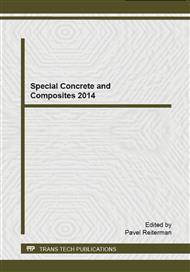p.99
p.104
p.110
p.116
p.122
p.128
p.132
p.138
p.143
Study of Accelerated Production of Prestressed Concrete Sleepers Using Strut-and-Tie Model
Abstract:
When designing the technological process for producing prestressed concrete sleepers on a large scale, it is especially important to achieve substantial reduction of production time due to the economic aspect. In this study, an estimation of the earliest possible time to release prestressing force from the wire with respect to bond development is presented, thus, allowing earlier removal and reuse of a prestressed concrete sleeper formwork. Time-dependent development of concrete compressive and tensile strength is defined according to fib Model Code 2010. A Strut-and-Tie Model has been adapted as a design method for establishing the transmission length required for anchoring prestressed wires in a prestressed concrete sleeper in accordance with the bond stress. Additional calculations have established that the method is consistent with the Eurocode approach.
Info:
Periodical:
Pages:
122-127
Citation:
Online since:
October 2014
Authors:
Price:
Сopyright:
© 2014 Trans Tech Publications Ltd. All Rights Reserved
Share:
Citation:


